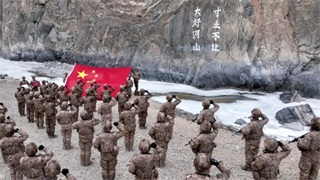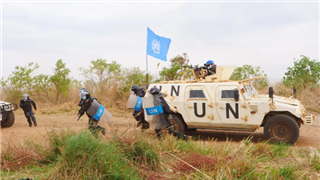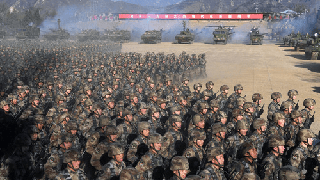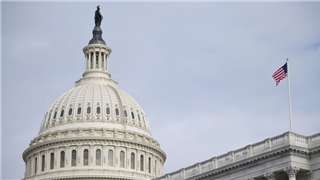朱春雨
By Zhu Chunyu
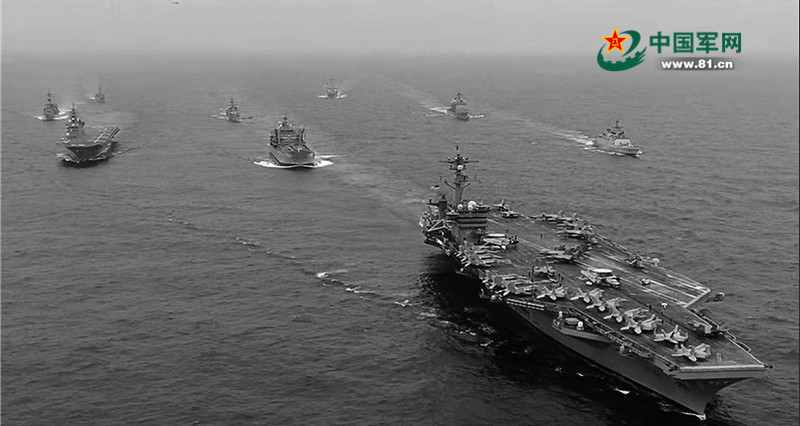
图①:日美印澳海上力量在孟加拉湾举行“马拉巴尔2021”演习。
The maritime forces of Japan, the US, India and Australia carry out Exercise Malabar 2021 in the Bay of Bengal.(File photo)
2021年12月4日至17日,美国海军陆战队与日本陆上自卫队在日本多地举行“坚毅之龙”演习,寻求通过完善双方指挥控制与协调程序,提高协同作战能力。
The US Marine Corps and the Japanese Ground Self-Defense Force (JGSDF) held the Resolute Dragon 21 exercise in Japan from December 4 to 17, 2021. The exercise aims to improve the command, control and coordination procedures of the two sides to improve their coordinated combat capabilities.
近年来,日本自卫队与美军以演训为抓手,不断强化“无缝合作”,持续验证联合行动预案,加速推进作战融合。与此同时,两国还加紧拉拢域内外国家在印太地区搅局。
In recent years, the Japanese Self-Defense Forces (JSDF) and the US military have used exercises as a starting point to continuously strengthen "seamless cooperation", continued to verify joint action plans, and accelerated combat integration. At the same time, the two countries have also stepped up to win over countries inside and outside the region to disrupt the situation in the Indo-Pacific region.
美国有意对日本“松绑”,而日本欲借美国之力扩大地区影响,日美在印太联手挑衅肇事的风险明显增大。
The US intends to "ease restrictions" on Japan, and Japan wants to use the power of the US to expand its regional influence. The risk of joint provocations in the Indo-Pacific has significantly increased.
根据日方公布的数据,2021年,日美举行双边联演40余次,占自卫队年度演习数量的一半以上。这些演习在规模、课目、地域等方面实现了不少突破。
According to data released by Japan, Japan and the US held more than 40 bilateral joint drills in 2021, accounting for more than half of the annual number of exercises by JSDF. These exercises have achieved many breakthroughs in terms of scale, subjects, and regions.
以往,驻日美军很少派出大规模兵力参加自卫队主导的演习,更多的是派员观摩或提供支援力量。然而,这一情况正在发生变化。去年11月19日至30日,美军出动了5800人参与日自卫队在日本周边海域及西南地区举行的“令和-03JX”联合演习。同月,美军出动10艘舰艇参与日海上自卫队在菲律宾海举行的“令和-03G”年度演习。
In the past, the US armed forces in Japan rarely sent large-scale troops to participate in exercises led by the JSDF. The US often sent personnel to observe or provide support. However, this situation is changing. The US dispatched 5,800 troops to participate in the Reiwa-03JX joint exercise with the JSDF in the waters surrounding Japan and the southwestern region from November 19 to 30 last year. In the same month, the US dispatched 10 ships to participate in the Reiwa-03G annual exercise with the Japanese Maritime Self-Defense Force (JMSDF) in the Philippine Sea.
日陆上自卫队与美陆军于2020年底启动“山樱”联合指挥所演习去年11月16日,日美首次在南海举行反潜战演习;去年12月进行的“坚毅之龙”实兵演习,更是日陆上自卫队与美海军陆战队史上最大规模演习。
The JGSDF and the US Army launched the Yama Sakura joint command post exercise at the end of 2020. On November 16, 2021, they held the first anti-submarine warfare exercise in the South China Sea. And then in December, the Resolute Dragon 21 exercise, largest one in the history of the JGSDF and the US Marine Corps, was conducted .
日美近期主导的一系列演练,大多以“西南有事”为基本想定,聚焦夺岛作战能力生成。日美加大常态化联合演训,既有“秀肌肉”的成分,也希望以此为牵引检验和强化联合作战能力,深化日美作战融合水平,为日美军事一体化提供基础。
The recent series of exercises led by Japan and the US mostly feature "incidents in the southwest" as the basic scenario and focus on the formation of island seizure combat capability. The reasons why Japan and the US have increased their normalized joint exercises include that they want to "flex muscles", and they also hope to use this to test and strengthen joint combat capabilities, deepen the level of Japanese-US combat integration, and provide a basis for Japan-US military integration.
当前,新冠疫情与百年变局叠加,国际力量格局深刻调整。美国实力相对下降,担忧自身霸权不保;日本倍感安全压力,愈发认为单凭一己之力难以应对“威胁”。在此背景下,日美都表示要共同应对挑战。
At present, combined impacts of changes unseen in a century and the COVID-19 pandemic resulted in profound changes in the international power structure. The US is relatively weakened and worried that its hegemony will not be guaranteed. Japan feels more security pressure and believes that it is difficult to respond to "threats" on its own. In this context, both Japan and the US have expressed their desire to jointly respond to the challenges.
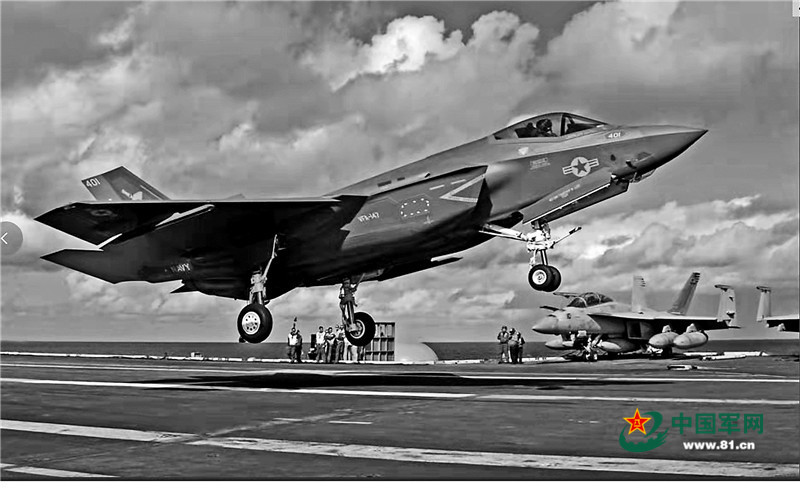
美拜登政府上台以来,继续大力推行“印太战略”,持续加大对印太地区的战略投入。美有意通过双多边演习高调炫耀武力,企图以此聚拢盟友伙伴,维持在印太地区事务上的主导权,并有意将日本塑造为战略竞争的桥头堡和军事对抗前沿基地,鼓励日承担更多同盟任务,以弥补自身实力不足。
Since the Biden administration came to power, it has continued to vigorously promote the "Indo-Pacific Strategy" and increase its strategic investment in the Indo-Pacific region. The US intends to show off its military force in a high-profile manner through bilateral and multilateral exercises to win over allies and partners to maintain its dominance in affairs of the Indo-Pacific region. The US also intends to portray Japan as a bridgehead for strategic competition and a frontier base for military confrontation, and encourage Japan to take on more alliance tasks to make up for its own lack of strength.
日本一方面要“倚美自保”,通过投靠美国和拉拢他国增加“底气”;另一方面则想“挟美自重”,借机推进军事转型。从长远看,日本此举具有更大的战略图谋,即提升日本在地区事务中的影响力,并为其介入全球事务、实现军事政治大国目标铺路。
On the one hand, Japan wants to "rely on the US to protect itself" and increase its "confidence" by relying on the US and winning over other countries. On the other hand, it wants to "take advantage of the US" and take the opportunity to advance its military transformation. In the long run, Japan's move has a greater strategic plan, that is, to enhance its influence in regional affairs and pave the way for it to intervene in global affairs and become a military and political power.
尤其值得警惕的是,日本正力图在美盟友体系中扮演更加重要的角色。近年来,日本自主意识不断增强,在美默许甚至支持下,正在从同盟中的“保护对象”逐步转变为“战区伙伴”甚至“全球伙伴”。未来,日本很可能继续联美强化在印太地区的存在和行动,两国在地区内联手滋事的风险不断增加。对这种动向,周边国家须高度警惕。
What is particularly worthy of vigilance is that Japan is trying to play a more important role in the US ally system. Japan's awareness of independence has continued to increase in recent years. With the acquiescence and even support of the US, Japan is gradually transforming from an "object of protection" in the alliance to a "combat zone partner" or even a "global partner." In the future, Japan is likely to continue to strengthen its presence and operations with the US in the Indo-Pacific region, and the risk of joint provocations in the Indo-Pacific will continue to increase. Neighboring countries must be highly vigilant against such trends.
(作者单位:军事科学院研究生院) (The author is from Graduate School of the PLA Academy of Military Science)

